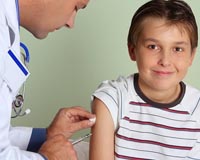| . |  |
. |
Washington (AFP) Oct 3, 2009 US health authorities are hoping to contain what they say is an intensifying swine flu pandemic with a massive A(H1N1) vaccination campaign that begins this Tuesday. "We expect Friday in our weekly update of FluView that we will be reporting substantial flu illness in most of the country, significant flu activity in virtually all states," said Anne Schuchat, director of the Center for Immunization and Respiratory Diseases at the Centers for Disease Control (CDC). "Most states do have quite a lot of disease right now, and that is unusual for this time of the year," she said at a press conference on Friday evening. Schuchat also shared her concern over the serious risks facing pregnant women infected with the virus, whose risk of dying from the A(H1N1) strain is effectively six times than for the general population. Between April and August, 100 pregnant women in the United States who contracted the virus were admitted to intensive care, and 28 died, Schuchat said. According to the most recent figures released by the CDC, 10,082 people have been hospitalized with swine flu in the United States so far, with 936 deaths from the virus, including 36 children. An analysis of post-mortem samples from 77 people who died from the virus showed that most had contracted a secondary infection; a third had pneumonia, for which there is no vaccine. Schuchat reiterated the importance of vaccination for pregnant women and other groups considered particularly vulnerable to the virus, including children, young adults up to 24 years old, and those suffering from certain other chronic medical problems. US health authorities on Friday announced plans for a massive vaccination campaign intended to protect millions of Americans, with the first distribution of 600,000 vaccine doses set for Tuesday, two weeks ahead of schedule. The United States expects to quickly dispense some six or seven million doses and hopes to administer 250 million doses by the end of the year. Clinical trials carried out on five different vaccines showed that a single dose of 15 micrograms is sufficient to cause an efficient immune response. "We are transitioning from the planning phase to the implementation phase," Schuchat said. "This is really just the beginning." Health professionals have welcomed the sooner-than-expected debut of the vaccine, hoping that the immunization will be able to protect millions of people at risk because of cardiac disease, obesity or asthma. The first vaccine doses are being made available in the form of nasal sprays that take effect in about eight days. But despite the early arrival of the vaccine, some 15 US states, including some of the most populated such as California, could run out of hospital beds if just 35 percent of the population becomes infected with the virus, according to a CDC information model. The figure was calculated based on the 1968 flu pandemic, which was considered fairly mild, and is based on the assumption that the infection period would last eight weeks. A recent report by the White House's Council of Advisors on Science and Technology, which modeled the outcomes of an infection rate of 30 percent, found up to 1.8 million Americans could require hospitalization and some 30,000 could die. That figure would be lower than the average of 36,000 Americans who die annually from seasonal flu, which usually begins around October. Share This Article With Planet Earth
Related Links Epidemics on Earth - Bird Flu, HIV/AIDS, Ebola
 US begins rolling out swine flu vaccine
US begins rolling out swine flu vaccineWashington (AFP) Oct 1, 2009 The United States said Thursday it has begun implementing a massive campaign to vaccinate millions of Americans against swine flu, with the first 600,000 doses to be distributed in coming days. Anne Schuchat, deputy director of the US Centers for Disease Control and Prevention (CDC), said 25 areas across the country -- among the 50 states and four main metropolitan areas identified in the CD ... read more |
|
| The content herein, unless otherwise known to be public domain, are Copyright 1995-2009 - SpaceDaily. AFP and UPI Wire Stories are copyright Agence France-Presse and United Press International. ESA Portal Reports are copyright European Space Agency. All NASA sourced material is public domain. Additional copyrights may apply in whole or part to other bona fide parties. Advertising does not imply endorsement,agreement or approval of any opinions, statements or information provided by SpaceDaily on any Web page published or hosted by SpaceDaily. Privacy Statement |